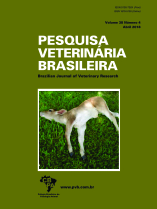 |
|
|
|
Year 2018 - Volume 38, Number 4
|

|
Histochemical characterization in the diagnosis of bovine babesiosis by Babesia bovis, 38(4):649-658
|
ABSTRACT.- Silva T.M., Areco W.V.C., Faccin T.C., Melo S.M.P., Fighera R.A. & Kommers G.D. 2018. [Histochemical characterization in the diagnosis of bovine babesiosis by Babesia bovis.] Caracterização histoquímica no diagnóstico da babesiose bovina por Babesia bovis. Pesquisa Veterinária Brasileira 38(4):649-658. Laboratório de Patologia Veterinária, Departamento de Patologia, Universidade Federal de Santa Maria, Av. Roraima 1000, Camobi, Santa Maria, RS 97105-900, Brazil. E-mail: glaukommers@yahoo.com
Babesiosis is a hemolytic tick-borne disease caused by intraerythrocytic protozoal parasites of the genus Babesia. This is a disease of high incidence in the southern Brazil and responsible for considerable economic losses. Clinical-pathological diagnosis can be made by demonstrating the parasite by examining blood smears or fresh tissues. However, frequently, only formalin-fixed organs are sent to pathology laboratories, which makes it impossible to perform the smears. The main objective of this study was to find alternative histochemical techniques capable to improve the identification of intraerythrocytic Babesia bovis in histological sections. For this study, tissue samples from 50 bovine necropsy cases were retrospectively analyzed, which had been fixed in formalin and routinely processed for histopathology. The cases were divided into a control group, consisting of 12 cases of cerebral babesiosis with characteristic pink-cherry gray matter (group A), and 38 cases suggestive of cattle tick fever (group B), according to necropsy protocols. Histochemical techniques of Alcian Blue, Methylene Blue, Toluidine Blue, Giemsa, Gram (McCallum-Goodpasture method), Grocott, Periodic Acid of Schiff and Ziehl-Neelsen were tested. Among these, it was observed that the techniques of Methylene Blue and Toluidine Blue allowed to observe morphological and dye characteristics in a clearer way, aiding in the identification of B. bovis. In addition, several clinical-epidemiological and anatomopathological parameters of babesiosis caused by B. bovis were established.
|
| |
|
|
| |
|
 |